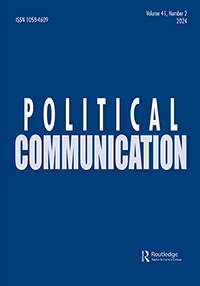视觉错误信息可信度认知研究议程
IF 4.6
1区 社会学
Q1 COMMUNICATION
引用次数: 7
摘要
摘要今天的政治错误信息越来越多地以视觉形式产生和消费,如照片、表情包和视频。尽管视觉媒体无处不在,学术界也越来越关注错误信息,但对视觉错误信息的研究相对匮乏。目前尚不清楚哪些特定的视觉格式(如模因、可视化)和特征(如颜色、人脸)单独或与非视觉特征和启发式相结合,以及通过什么机制对视觉错误信息的影响做出了贡献。针对这些差距,我们确定了一个理论框架,解释视觉特征在借贷可信度中的说服机制和途径(例如,作为论据、启发法和注意力决定因素)。我们提出了一份可信度感知的相关视觉属性列表,并提出了一项研究议程,该议程整合了包括计算视觉分析、众包注释和实验在内的方法,以提高我们对视觉错误信息的理解。本文章由计算机程序翻译,如有差异,请以英文原文为准。
An Agenda for Studying Credibility Perceptions of Visual Misinformation
ABSTRACT Today’s political misinformation has increasingly been created and consumed in visual formats, such as photographs, memes, and videos. Despite the ubiquity of visual media and the growing scholarly attention to misinformation, there is a relative dearth of research on visual misinformation. It remains unclear which specific visual formats (e.g., memes, visualizations) and features (e.g., color, human faces) contribute to visual misinformation's influence, either on their own or in combination with non-visual features and heuristics, and through what mechanisms. In response to these gaps, we identify a theoretical framework that explains the persuasive mechanisms and pathways of visual features in lending credibility (e.g., as arguments, heuristics, and attention determinants). We propose a list of relevant visual attributes to credibility perceptions and a research agenda that integrates methods including computational visual analysis, crowdsourced annotations, and experiments to advance our understanding of visual misinformation.
求助全文
通过发布文献求助,成功后即可免费获取论文全文。
去求助
来源期刊

Political Communication
Multiple-
CiteScore
13.90
自引率
2.70%
发文量
30
期刊介绍:
Political Communication is a quarterly international journal showcasing state-of-the-art, theory-driven empirical research at the nexus of politics and communication. Its broad scope addresses swiftly evolving dynamics and urgent policy considerations globally. The journal embraces diverse research methodologies and analytical perspectives aimed at advancing comprehension of political communication practices, processes, content, effects, and policy implications. Regular symposium issues delve deeply into key thematic areas.
 求助内容:
求助内容: 应助结果提醒方式:
应助结果提醒方式:


